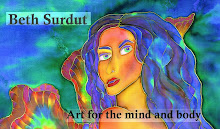The Art of Paying Attention: Hummingbird Etiquette
© Beth Surdut, 2016
Audio on NPR/Arizona Spotlight
This story starts with bird droppings. But before I go any further,
if you have a penny and a quarter handy, please hold one of each in the
palms of your hands while we embark on a treasure hunt.
Tiny white bird droppings splashed onto a walkway that led to my
front door in New Mexico. Each day, more splotches accrued on the same
piece of blue flagstone. So, I looked up.
About 6 feet above me, on a slim branch of a juniper tree, a
broad-tailed hummingbird, her weight approximately the same as a penny,
had crafted her nest, the size of a quarter and maybe an inch deep. The
materials she chose included lichen, leaves, bark, and grasses
interwoven with spider webs and lined with what looked like downy
milkweed and feathers. Inside were two chicks, each about the size of
one of my fingernails.
As the birds grew, the nest stretched to accommodate them, because it
was purposely made pliable by the spider webs that also secured it to
the branch.
My drawing of these broad-tailed siblings shows them not long before
they fledged three weeks from the time they were born. Their beaks,
which began as nubs, are almost full length. Their feathers, with only
hints of the green iridescence that will deepen in maturity, have
emerged from tiny hollow tubes of cartilage.
I don’t know if I ever saw those particular juveniles after they left
the nest, but one day, I was working on a drawing, magnifying glass in
one hand, ink pen in the other, when I heard wing beats —so close, I
could feel the air puff on forehead. I held my breath, raised only my
eyes, and looked at the hummingbird looking at me. Face to face, we both
seemed suspended in the heartbeat of the universe before the bird
turned and flew out through the open door.
Every time I have held a hummingbird— only out of necessity—is due to the nest building of a large invasive species—humans.
Another time, a broad-tail flew into my studio. She bounced
repeatedly against the window, as I flew across the room saying, “No,
no, no!”
Landing on the wide sill, she fluttered between the glass and a
painted wood cut-out of two flamenco dancers. Her emerald wings winked
at the edges of the woman’s ruby skirt.
I cupped the bird loosely in my hands, my fingers forming the bars of
a cage. Quiet, she brushed the side of her beak along my finger.
Eyes bright and dark, she looked at me. Didn’t seem scared. Curious, I think.
I wanted to ask her what she’d seen on her journeys.
I wanted to invite her to stay and build a nest out of spider webs.
What I wanted, though, wasn’t the point, so I walked her to the open doorway and opened my hands.
Last summer, I was standing outside my big studio window here in
Tucson. My pink shirt was garnering inspection from a purple-headed
Costa’s hummingbird who poked me and a male Anna’s whose rosy-red crown
and glittering throat flashed as he swooped around me. Then I heard that
heart-dropping impact of body slamming into glass, and I looked down to
see another Anna’s conked out on the ground.
She looked perfect, but as time passed, she didn’t move, didn’t open
her eyes, so I picked up her little body and held it in my hand.
“Please be okay, please live, little one.” I waited, standing in the sunlight.
The bird was on its back—so vulnerable.
“Please.”
Tiny feet moved, eyes opened. She lay there, then turned over, so
light on my palm. I felt her throb, filling all the air sacks in her
body, and then this miraculous jewel of a creature flew up and zoomed
through the cloudless blue sky.
Subscribe to:
Post Comments (Atom)









1 comment:
As usual, Beth, I love not only your paintings but also your writings. Was fun to see this. Miss you. What are you doing in Tucson? I can't keep up.
Post a Comment